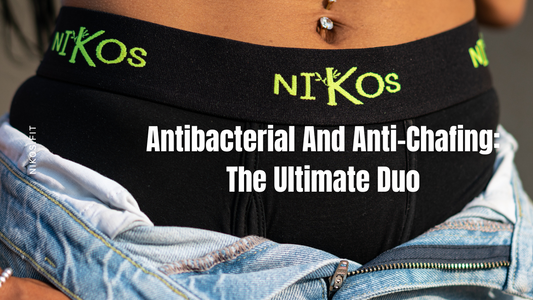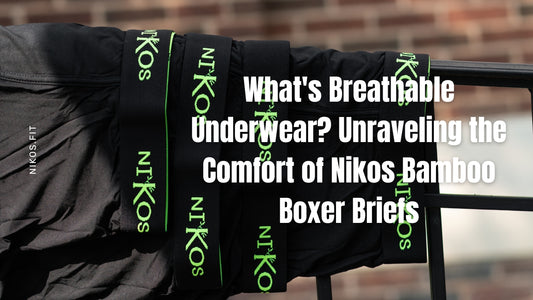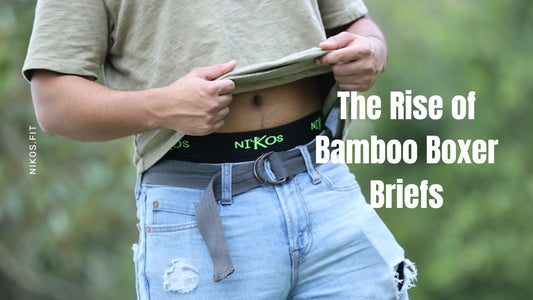
Bamboo vs Cotton Underwear: A Comprehensive Comparison
In the quest for daily comfort and personal well-being, the choice of underwear fabric plays a pivotal role. As we navigate through our bustling lives, the material caressing our skin can make a world of difference in how we feel and move. In recent years, there has been a significant shift in consumer preferences towards sustainable and comfortable clothing options. This growing awareness and interest in eco-friendly choices have brought two major contenders into the spotlight: bamboo and cotton. While cotton has long been a staple in the textile industry, bamboo is emerging as a revolutionary alternative, lauded for its softness and environmental benefits. This rise in popularity calls for a thorough comparison between bamboo and cotton underwear, delving into aspects of comfort, sustainability, and overall wear experience. As we embark on this comparative journey, let's uncover the nuances that set these fabrics apart and help you make an informed decision for your everyday comfort.
The Basics of Bamboo and Cotton Fabric
Following the introduction that emphasizes the growing preference for sustainable and comfortable underwear options, it's crucial to dive into the core of our comparison: the basics of bamboo and cotton fabrics. Understanding where these materials come from and how they are processed is key to appreciating their unique qualities and impacts.
Bamboo Underwear: Source and Sustainability
Bamboo fabric, a relatively new entrant in the textile arena, originates from the bamboo plant, a fast-growing grass that thrives in diverse climates without needing pesticides or fertilizers. This rapid growth and low maintenance make bamboo an eco-friendly resource. The transformation of bamboo into fabric involves pulping the bamboo stalks into cellulose, which is then spun into fibers. This process, while varied in its environmental impact depending on the method used, often utilizes closed-loop systems that recycle water and solvents, further enhancing its sustainability profile. The end product is a soft, breathable material that is increasingly favored for underwear due to its natural comfort and eco-conscious appeal.
Cotton Underwear: Tradition and Environmental Considerations
In contrast, cotton, a time-honored textile staple, comes from the cotton plant's fluffy bolls. Cotton's journey from plant to fabric is more traditional, involving cultivation, harvesting, ginning (separating cotton fibers from seeds), and spinning. While cotton's natural origin gives it a classic appeal, its environmental footprint raises concerns. Conventional cotton farming is water-intensive and often relies on significant pesticide use, contributing to soil and water pollution. Although organic cotton offers a more sustainable alternative, it still grapples with the issue of water usage. As such, the traditional cotton production process presents environmental challenges that are increasingly scrutinized in our sustainability-conscious world.
In this comparison of bamboo and cotton underwear, we delve into not just the comfort they offer but also their journey from natural resources to the fabric. This exploration sheds light on the environmental implications of our choices, guiding us toward more informed decisions in our quest for comfortable and responsible underwear options.
Comfort and Durability
After understanding the basic nature and environmental aspects of bamboo and cotton fabrics, it's time to delve into two critical factors that significantly influence our choice of underwear: comfort and durability. How these fabrics feel against the skin and how long they last are vital considerations for anyone looking for the ideal underwear material.
Comfort: Bamboo vs. Cotton
Bamboo Underwear:
- Feel Against the Skin: Bamboo fabric is renowned for its exceptional softness, often compared to that of cashmere or silk. This smooth texture makes it a pleasure to wear, especially for those with sensitive skin.
- Breathability: Bamboo underwear excels in breathability. Its natural fibers allow air to circulate freely, keeping the skin cool and comfortable.
- Moisture-Wicking Properties: Bamboo is highly absorbent and wicks moisture away from the skin, making it an excellent choice for warmer climates or for those leading active lifestyles.
- Suitability for Sensitive Skin: The hypoallergenic properties of bamboo fabric make it suitable for sensitive skin, reducing the likelihood of irritation and allergic reactions.
Cotton Underwear:
- Feel Against the Skin: Cotton, being a natural fiber, is also soft and gentle on the skin. Its comfort is well-known, making it a staple in the underwear industry.
- Breathability: Cotton is breathable, though not as much as bamboo, which can be a drawback in hotter conditions or during physical activities.
- Moisture-Wicking Properties: Cotton tends to absorb moisture but does not wick it away as effectively as bamboo. This can lead to a feeling of dampness, especially in humid conditions.
- Suitability for Sensitive Skin: While cotton is generally considered good for sensitive skin, it may not be as hypoallergenic as bamboo, especially if treated with chemicals during processing.
Durability: Longevity and Wear Resistance
Bamboo Underwear:
- Longevity: Bamboo fibers are strong and durable. When properly cared for, bamboo underwear retains its shape and softness over time, resisting pilling and wear.
- Wear Resistance: The resilience of bamboo fabric against daily wear and tear is notable, often outlasting its cotton counterparts in maintaining quality and appearance.
Cotton Underwear:
- Longevity: Cotton is known for its durability. It can withstand multiple washes and regular wear, though it may lose some of its softness and become thinner over time.
- Wear Resistance: Cotton fabric can endure daily activities well, but it may be prone to shrinking and faster wear compared to bamboo, especially in lower-quality variants.
In summary, both bamboo and cotton underwear offer distinct advantages in terms of comfort and durability. Bamboo stands out for its superior softness, breathability, moisture-wicking, and hypoallergenic properties, making it ideal for active lifestyles and sensitive skin. Cotton, while comfortable and durable, may lag slightly behind in moisture management and long-term wear resistance. The choice between bamboo and cotton ultimately depends on personal preference, lifestyle, and skin sensitivity.
Environmental Impact
Building on our understanding of the comfort and durability of bamboo and cotton fabrics, it is equally important to consider their environmental impact. The eco-friendliness of our clothing choices is a growing concern, and the comparison between bamboo and cotton in this regard is particularly revealing.
Environmental Impact of Bamboo Fabric
Eco-Friendly Aspects:
- Less Water Usage: Bamboo plants require significantly less water compared to cotton. They thrive naturally without artificial irrigation, making them a more sustainable choice in regions facing water scarcity.
- Pesticide-Free Growth: One of the most notable eco-friendly aspects of bamboo is its natural resistance to pests and diseases. This means bamboo can be grown without the use of harmful pesticides and herbicides, reducing environmental pollution and promoting biodiversity.
- Rapid Renewability: Bamboo is one of the fastest-growing plants in the world, capable of reaching maturity in just a few years. This rapid renewability ensures a sustainable and continuous supply without depleting natural resources.
- Carbon Absorption: Bamboo plants are efficient at absorbing carbon dioxide and releasing oxygen, contributing positively to the battle against climate change.
Environmental Impact of Cotton Fabric
Challenges in Cotton Farming:
- High Water Consumption: Cotton farming is notoriously water-intensive. It requires significant amounts of water for irrigation, contributing to water stress in several cotton-growing regions.
- Pesticide and Chemical Use: Cotton crops account for a substantial proportion of the world's pesticide use. These chemicals can have detrimental effects on the soil, water, and surrounding ecosystems. Additionally, the use of synthetic fertilizers in cotton farming contributes to soil degradation and pollution.
- Land Use: The cultivation of cotton requires large areas of land, potentially leading to deforestation and habitat loss. This land use can also contribute to soil erosion and decrease in soil fertility over time.
- Emissions and Energy Usage: The processing and manufacturing of cotton into fabric involve energy-intensive procedures, contributing to greenhouse gas emissions and overall environmental footprint.
The environmental considerations of bamboo and cotton underline the importance of sustainable practices in the textile industry. While bamboo presents a more eco-friendly profile with its lower water needs, lack of pesticide reliance, and beneficial carbon footprint, cotton, especially conventionally grown cotton, faces several environmental challenges. However, it is worth noting that advancements in sustainable cotton farming practices, such as organic cotton, are making strides towards reducing these environmental impacts.
Cost and Accessibility
After exploring the environmental impacts of bamboo and cotton, it's crucial to consider another practical aspect influencing consumer choices: cost and accessibility. This section will compare the price range and availability of bamboo versus cotton underwear in the market, with a special focus on the accessibility of Nikos products.
Cost Comparison: Bamboo vs. Cotton
Bamboo Underwear:
- Price Range: Bamboo underwear generally falls into a higher price bracket compared to conventional cotton. This is due to the more complex processing required and its positioning as a premium, eco-friendly product.
- Factors Influencing Price: The cost of bamboo underwear also reflects its durability, comfort, and sustainable qualities. Investing in bamboo underwear can be seen as a long-term investment in quality and environmental responsibility.
Cotton Underwear:
- Price Range: Cotton underwear is widely available in a range of prices, often more affordable than bamboo variants. This affordability makes it accessible to a broader market.
- Variations in Price: The price of cotton underwear can vary based on factors such as quality, brand, and whether it is made from conventional or organic cotton.
Accessibility and Availability: Nikos's Approach

Nikos Bamboo Underwear:
- Market Availability: Nikos specializes in high-quality bamboo underwear, offering a range of styles and sizes that cater to diverse customer needs. While the price point for Nikos products might be higher than average cotton underwear, it reflects the premium quality and sustainable manufacturing practices.
- Nationwide Shipping: Understanding the importance of accessibility, Nikos ensures fast and reliable shipping across the nation. This commitment to customer service makes it convenient for customers to receive their eco-friendly underwear choices promptly, regardless of their location.
Availability in the Broader Market:
- Bamboo Underwear: Generally, bamboo underwear is becoming more accessible as demand for sustainable fashion grows. However, its availability can still be limited compared to cotton, especially in physical retail stores.
- Cotton Underwear: Cotton underwear remains ubiquitous and can be found in nearly every clothing store, from high-end boutiques to budget retailers.
In conclusion, while bamboo underwear, including Nikos products, may come with a higher price tag, it offers value in terms of sustainability, comfort, and quality. The growing market for bamboo underwear, combined with efforts by brands like Nikos to increase accessibility through efficient nationwide shipping, is making this eco-friendly option more attainable for consumers who prioritize sustainability alongside comfort and style.
Style and Variety
Moving beyond the practical aspects of fabric choice, cost, and accessibility, another vital factor in selecting underwear is the range of available styles and designs. This section delves into the variety offered in both bamboo and cotton underwear, with a special emphasis on the styles available at Nikos.
Style Options in Bamboo and Cotton Underwear
Bamboo Underwear:
- Current Trends: Bamboo underwear has seen a surge in design innovation, thanks to its growing popularity. Initially limited in style options, bamboo underwear now comes in various cuts and designs, catering to different preferences and body types.
- Innovative Designs: Many brands are exploring creative designs in bamboo underwear, focusing on both comfort and aesthetics. This includes a range of colors, patterns, and fits that appeal to a diverse customer base.
Cotton Underwear:
- Wide Variety: Being a long-standing favorite in the underwear market, cotton underwear boasts an extensive range of styles. From classic briefs to trendy boxer briefs, and from minimalist designs to patterned options, the variety is vast.
- Inclusivity in Design: Cotton underwear brands have traditionally led the way in offering styles that cater to all ages, sizes, and gender preferences, setting a benchmark for inclusivity in underwear fashion.
Nikos: Focused Style with Plans for Expansion
Nikos's Current Offerings:
- Men's Style: Nikos currently offers a singular, meticulously crafted style for men. This style is designed for optimum comfort, fitting seamlessly into the daily routine of the modern man.
- Women's Style: Similarly, for women, Nikos has introduced a thoughtfully designed style that promises comfort and sustainability. This initial offering reflects the brand's commitment to quality and eco-friendliness.
Future Plans for Variety:
- Expansion with Support: Nikos is poised for growth, with plans to expand its range of styles and designs. The brand envisions a future where, with continued customer support and increasing sales, it can diversify its offerings. This expansion will focus on introducing more styles and design choices, accommodating a broader spectrum of customer preferences.
- Commitment to Sustainability and Style: In all future endeavors, Nikos remains committed to balancing sustainability with fashion. Each new style introduced will adhere to the brand's core values of eco-consciousness and high-quality comfort.
In summary, while both bamboo and cotton underwear provide a range of options in terms of style and design, Nikos currently focuses on a select offering for men and women. The brand's commitment to expanding its range, fueled by customer support and sales, promises a future where consumers have access to a wider variety of sustainable, stylish, and comfortable underwear choices.
Care and Maintenance
After exploring the range of styles and designs in bamboo and cotton underwear, it's essential to understand how to care for these fabrics to ensure their longevity and maintain their quality. Proper care and maintenance are key to extending the life of your underwear, regardless of the material. This section provides practical tips for caring for both bamboo and cotton underwear.
Caring for Bamboo Underwear
Washing Guidelines:
- Gentle Cycle: Use a gentle wash cycle or hand wash bamboo underwear in cold water to preserve the fabric's softness and strength.
- Mild Detergent: Opt for a mild, eco-friendly detergent. Harsh chemicals can break down the fibers and reduce the lifespan of the fabric.
- Avoid Bleach and Fabric Softeners: These can degrade the material and diminish the natural properties of bamboo, such as its moisture-wicking abilities.
Drying and Storage:
- Air Dry: If possible, air dry bamboo underwear to maintain its shape and elasticity. Avoid using a tumble dryer, as high heat can damage the fibers.
- Fold Gently: Store by gently folding the underwear, avoiding stretching or crumpling, to keep its shape intact.
Caring for Cotton Underwear
Washing Tips:
- Warm Wash: Cotton underwear can generally be washed in warm water, which helps to remove body oils and sweat.
- Stain Treatment: Pre-treat any stains before washing, as cotton can hold onto stains more readily than bamboo.
- Color Separation: Wash colors separately to prevent bleeding, especially for darker or vibrant cotton fabrics.
Drying and Ironing:
- Tumble Dry Low: Cotton underwear can be tumble dried on a low setting, but be mindful of potential shrinkage.
- Ironing: If needed, cotton underwear can be ironed on a low heat setting. However, this is usually not necessary for daily wear.
By following these care and maintenance tips, you can ensure that your bamboo and cotton underwear remains in excellent condition, providing comfort and durability over time. Proper care not only extends the life of the underwear but also supports sustainable practices by reducing the need for frequent replacements.
Making an Informed Choice
As we reach the end of our comprehensive exploration into the world of underwear fabrics, it's clear that both bamboo and cotton offer unique benefits and considerations. This article has taken you through a detailed journey, comparing bamboo and cotton across various dimensions - from their origins and environmental impact to their comfort, style, and maintenance. Here's a brief summary of the key points:
- The Basics of Bamboo and Cotton Fabric: Bamboo stands out for its eco-friendliness, with sustainable growth and processing, while cotton is a traditional textile with a more significant environmental footprint.
- Comfort and Durability: Bamboo offers superior softness, moisture-wicking properties, and is well-suited for sensitive skin, whereas cotton is known for its classic comfort and durability.
- Environmental Impact: Bamboo's low water usage and pesticide-free growth make it an environmentally favorable option, in contrast to the high water consumption and chemical use associated with conventional cotton farming.
- Cost and Accessibility: Bamboo underwear, exemplified by Nikos's offerings, typically comes at a higher price point but reflects a commitment to quality and sustainability. Cotton underwear is more widely available and generally more affordable.
- Style and Variety: While bamboo underwear is evolving in terms of style diversity, cotton underwear has long been available in a wide range of designs. Nikos is on a path to expanding its bamboo underwear range, promising more variety with continued support and sales.
- Care and Maintenance: Proper care of both bamboo and cotton underwear is crucial for extending their lifespan, with each requiring specific but manageable care practices.
In making a choice between bamboo and cotton underwear, it ultimately boils down to personal preferences and priorities. If sustainability, skin sensitivity, and modern innovation align with your values, bamboo underwear from brands like Nikos could be the ideal choice. On the other hand, if you prefer the traditional comfort and wider availability of styles, along with a lower price point, cotton underwear might be more suitable.
Each fabric has its strengths and appeals to different needs and values. By considering factors like comfort, environmental impact, cost, style, and care requirements, you can make an informed decision that aligns with your personal preferences and lifestyle choices, ensuring that your underwear is not just an afterthought but a conscious, comfortable, and responsible choice.
Discover the Comfort of Nikos Bamboo Underwear
Now that you've journeyed through the detailed comparison of bamboo and cotton underwear, why not experience the difference firsthand? We invite you to explore the Nikos range of bamboo underwear, where sustainability meets unparalleled comfort.
Our collection, carefully crafted from eco-friendly bamboo fabric, offers a unique blend of softness, breathability, and durability. Designed for the conscious consumer who values both environmental responsibility and personal comfort, our bamboo underwear stands as a testament to the fact that you don't have to compromise on style or comfort to make eco-friendly choices.
Whether you're seeking to make a positive impact on the environment or looking for underwear that keeps up with your active lifestyle while offering superior comfort, Nikos has something for everyone. With our focused range for men and women, and plans to expand as our community grows, we're excited to be a part of your sustainable fashion journey.
Take the next step:
- Visit Nikos Bamboo Underwear to browse our collection.
- Feel the difference of bamboo's softness and durability.
- Join our journey towards expanding our range, fueled by your support and belief in sustainable fashion.
Make your choice count. Choose comfort, choose style, choose sustainability. Choose Nikos.





